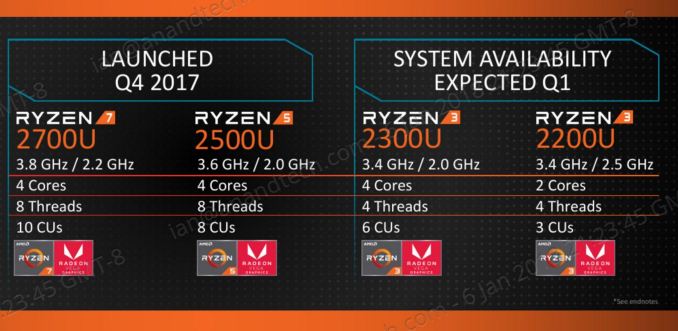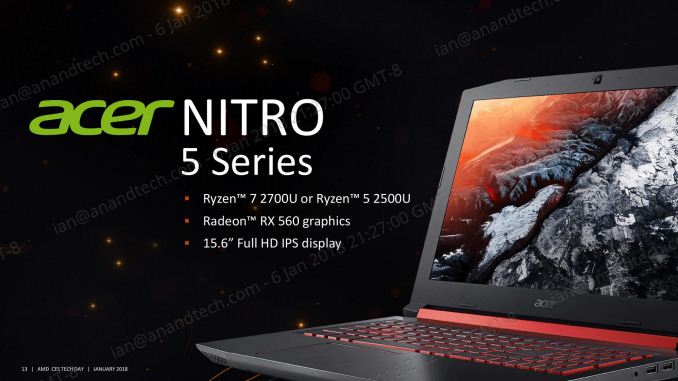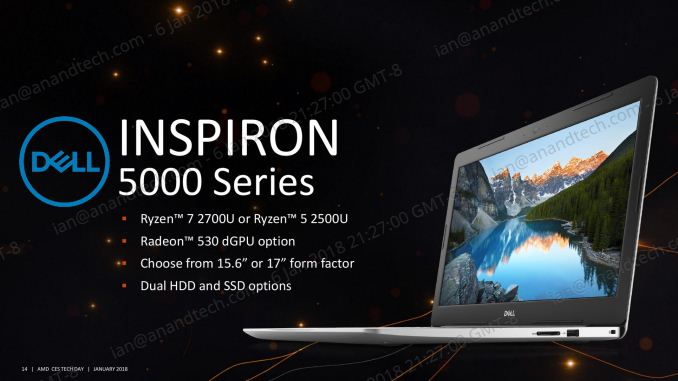AMD Tech Day at CES: 2018 Roadmap Revealed, with Ryzen APUs, Zen+ on 12nm, Vega on 7nm
by Ian Cutress on February 1, 2018 8:45 AM ESTZen Cores and Vega
Ryzen 3 Mobile, Plus More Ryzen Mobile Laptops
The most immediate announcement from AMD is two Ryzen 3 Mobile processors designed to fill out the Mobile stack, and the introduction of Ryzen-based APUs for desktop machines.
At the heart of both of these designs is the combination of AMD’s first-generation Zen cores, specifically four cores in a ‘core complex’, connected to Vega-based graphics integrated into the silicon. The two units are connected via AMD’s Infinity Fabric, designed for high-bandwidth and scale, and a feature that permeates through AMD’s recent product portfolio.
Ryzen Mobile
To date, AMD has already announced two products using this configuration. Both of them are for Ryzen Mobile, specifically the Ryzen 7 2700U and Ryzen 5 2500U, which have already been pre-announced in devices such as the HP Envy x2, the Lenovo Ideapad 720S, and the Acer Swift 3. Only the HP Envy x2 has been launched into the market so far (with mixed reviews due to the OEM design, which draws similar criticisms when equipped with Intel CPUs), with the others to see light in Q1 as well as other OEMs like Dell.
The first announcement is regarding adding more Ryzen Mobile processors to the family to cater for a wider audience. To pair with the Ryzen 7 Mobile and Ryzen 5 Mobile, AMD has two Ryzen 3 Mobile parts which will formally be available on January 9th with expected system availability within Q1.
| AMD Ryzen Mobile APUs | |||||
| Ryzen 7 2700U with Vega 10 |
Ryzen 5 2500U with Vega 8 |
Ryzen 3 2300U with Vega 6 |
Ryzen 3 2200U with Vega 3 |
FX-9800P (2015) |
|
| CPU | 4C / 8T 2.2 GHz Base 3.8 GHz Turbo Zen 14nm |
4C / 8T 2.0 GHz Base 3.8 GHz Turbo Zen 14nm |
4C / 4T 2.0 GHz Base 3.4 GHz Turbo Zen 14nm |
2C / 4T 2.5 GHz Base 3.4 GHz Turbo Zen 14nm |
Dual Module 2.7 GHz Base 3.6 GHz Turbo Excavator 28nm |
| GPU | Vega 10 10 CUs 640 SPs < 1300 MHz |
Vega 8 8 CUs 512 SPs < 1100 MHz |
Vega 6 6 CUs 384 SPs |
Vega 3 3 CUs 192 SPs |
GCN 1.2 8 CUs 512 SPs > 758 MHz |
| TDP | 15W | 15W | 15 W | 15 W | 15W |
| DRAM | Up to DDR4-2400 | DDR4-1866 | |||
| L2 Cache | 512 KB/core | 1 MB/module | |||
| L3 Cache | 1 MB/core | 4 MB/core | - | ||
| PCIe Lanes | ? | ? | ? | ? | 8 x PCIe 3.0 |
| Die Size | 209.78 mm2 | 250.4 mm2 | |||
| Transistors | 4.95 billion | 3.1 billion | |||
| Launch | October 2017 | January 2018 | May 2016 | ||
The Ryzen 3 2300U is a quad-core processor without simultaneous multithreading, which separates it from the other components. The base frequency of 2.0 GHz, a top turbo of 3.4 GHz, and a total of six compute units in the Vega graphics (this equates to 384 streaming processors). The Ryzen 3 2300U shares the same TDP as the other parts, coming in at 15W, and AMD wants to position this as a high-performance part for eSports capable notebooks, handily beating anything from Intel’s 7th Generation family.
The Ryzen 3 2200U is the only dual core component in AMD’s entire Ryzen product line, although it does have simultaneous multithreading to give it four threads in total. Having two fewer cores to fire up does give it a boost on the base frequency, coming in at 2.5 GHz, but the turbo frequency matches the other Ryzen 3 at 3.4 GHz. The 2200U is certainly the processor bringing up the rear, with only three compute units (192 streaming processors) in total, and helping AMD shift some of the processors that are not binned as aggressively as the higher-performance units.
AMD is promoting these two processors as capable elements of an entry level 15W notebook that can process DirectX 12, offer advanced video features, and be used in aesthetically pleasing designs with a long battery life, including 2-in-1s, ultrathin notebooks, and gaming laptops.
New Devices
Not to be content with just announcing a couple of new Ryzen Mobile processors, AMD was eager to promote new mobile devices that will be using Ryzen Mobile. To accompany the HP Envy x360, the Lenovo Ideapad 720S, and the Acer Swift 3, Q1 will see the launch of a new HP (under embargo until later this week), the Acer Nitro 5 series, and the Dell Inspiron 5000 series.
Acer’s Nitro line of laptops is typically aimed at the gaming crowd. The Nitro 5 dictates a 15.6-inch display, which in this case is a 1920x1080 IPS panel. Acer will use the pre-announced higher-end APUs, the Ryzen 7 2700U and Ryzen 5 2500U, but will also be pairing this with a Radeon RX 560 graphics chip. We were told by AMD that the integrated graphics and discrete graphics will be used in a switching context: for video playback, the lower power integrated graphics is used and the discrete is disabled, however the discrete graphics is fired up for gaming work. For compute, or for games that support multi-adaptor DirectX 12 technologies, both the integrated graphics and the discrete graphics should be available, however this is up to the game/software to implement.
The Dell Inspiron lines are more home/small-medium business-oriented devices, and here Dell is also using the Ryzen 7 2700U and Ryzen 5 2500U processors to offer peak Mobile APU performance. Designed more as a workhorse than for aesthetics, the Inspiron 5000 will offer AMD parts with 15.6-inch and 17-inch displays in a chassis that can support dual HDD/SSD options. The unit also comes with an optional Radeon 530 discrete GPU, which has 384 compute units based on AMD’s older GCN 1.0 architecture. This comes across as very odd, given that even the Ryzen 5 has 512 compute units of the newer Vega architecture. I can only assume that this provides extra displays for very specific customers, though for most it would seem an overly pointless addition.














131 Comments
View All Comments
mikabr - Monday, January 8, 2018 - link
What is the status of thunderbolt and AMD today? Can Apple or similar manufacturer take AMD parts and create something that does the same thing as a Macbook pro or iMac today, with thunderbolt ports that has the same functionality as todays Intel based offerings?A5 - Monday, January 8, 2018 - link
In theory, the TB controller is just a hunk of silicon hanging off the PCIe bus. But the fact that Intel is the only manufacturer is a probably an issue.Space Jam - Monday, January 8, 2018 - link
Maybe I haven't been paying attention but i've just started to notice how low quality images on this site actually are, though especially in this article. That image of Lisa Su looks like its from an early 2000s budget digital camera using digital zoom. Why are the slideshow caps horrendously compressed JPEGs?Get well soon Ian.
Ian Cutress - Monday, January 8, 2018 - link
Click through for full resolution.jjj - Monday, January 8, 2018 - link
Vega on 7nm is likely very bad news if it's more than this SKU targeted at machine learning as it implies that Navi is very late and AMD stays utterly uncompetitive in GPU.haukionkannel - Thursday, February 1, 2018 - link
And if Vega7 is small chip. It may be used in self driving cars and other small for factor special cases where the price is not so big problem.wr3zzz - Monday, January 8, 2018 - link
Can mobile Ryzen go down to 4.5W TDP for fanless designs?st_7 - Monday, January 8, 2018 - link
@Ian Cutress. looks like a typo in this line "The Ryzen 5 2200U is the only dual core component in AMD’s entire Ryzen product line", I think it should be "The Ryzen 3 2200U".And also is there any information, if AMD planning to release mobile processors which can go against Intel HQ line of mobile/laptop processors, presuming that these 'U' processors are pitted against Intel 'U' processors. Or these 'U' processors from the AMD are the only mobile/laptop class processors that we gonna see from AMD in the next year or two.
jjj - Monday, January 8, 2018 - link
- so few mobile SKUs, why no 45W SKUs, no 11CU SKUs- so few desktop APU SKUs and what do they have above 170$ and maybe bellow 100$
- Vega on 7nm in 2019 while Navi also in 2019, area you certain that Navi+ is 2020 or is that an assumption, because if seems that if Vega on 7nm goes everywhere, Navi can't be 2019 and Naxi+ wouldn't be 2020
- 7nm+ being a second gen 7nm is your assumption or AMD stated that. in theory could be what comes after 7nm so 5nm
- where are the 150-250$ new gen GPUs, I get that they are too lazy to meet demand with the current ones but perf per $ is atrocious and they'll kill gaming at this pace
- being surprise that Zen 2 is done is odd, AMD might have Epyc 2 on 7nm in late 2019 so ofc the core is done. And ofc , with that in mind, when you say Zen 2 2019, in consumer at least as server could be different
- where is a Rave Ridge refresh in H2 this year? They really don't have one or
- we don't care about efficiency gains with Pinnacle Ridge, we need higher clocks, better memory support, some minimal SoC level gains and maybe same cache changes but we really just need anything from 4.5GHz to 7GHz- where they land in that range defines how open our wallets are. OK we want more PCIe too and if they could support much faster memory, we would even take more then 8 cores.
Anyway, this seems like a rather incomplete roadmap.
jjj - Monday, January 8, 2018 - link
And why so few RR system and mostly 15 in and up